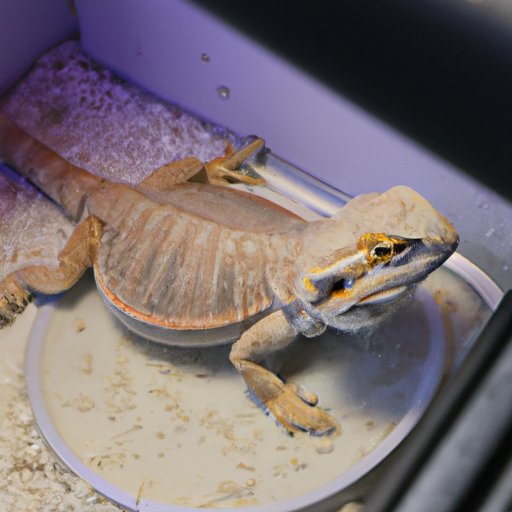Introduction
Bearded dragons are one of the most popular reptile pets due to their generally friendly and docile nature. These medium-sized lizards are native to Australia and thrive in warm, arid climates. Taking on the responsibility of caring for a bearded dragon means understanding its unique needs and providing a balanced diet, safe enclosure, and appropriate temperatures. This article is designed to provide an essential guide to bearded dragon care so that your pet can live a long and healthy life.
Create an Appropriate Habitat
The first step in caring for a bearded dragon is creating a suitable habitat. It’s important to choose an enclosure that offers plenty of space for the dragon to move around comfortably. A terrestrial tank or terrarium with a secure lid is best. Be sure to select one that’s at least 20 gallons and has plenty of ventilation.
Once you have the enclosure set up, it’s time to add substrate and accessories. You can use a variety of substrates such as sand, soil, newspaper, or even tile. Avoid using loose substrate for young dragons as they may accidentally ingest it. Accessories such as rocks, logs, and branches will help create a natural environment for your pet.
Provide the Right Temperature and Humidity
Bearded dragons require different temperatures and humidity levels in order to stay healthy. You should invest in a thermometer and hygrometer to monitor the temperature and humidity in the enclosure. The ideal temperature range for a bearded dragon is between 80 and 90 degrees Fahrenheit. To create a basking area, use a heat lamp to provide a warmer spot in the enclosure.
Humidity should be kept between 30 and 40 percent. To increase the humidity, mist the enclosure lightly every day. You can also place a shallow dish of water in the enclosure to help keep humidity levels stable.
Feed a Balanced Diet
A balanced diet is essential for bearded dragons to stay healthy. Offer a variety of food sources such as crickets, mealworms, waxworms, and other insects. Vegetables such as kale, collard greens, and squash should also be included. Fruits such as apples and blueberries can be offered occasionally as treats. Make sure the food is properly sized for your dragon—it should be no larger than the distance between the dragon’s eyes.
Handle with Care
Bearded dragons are very gentle creatures and should be handled with care. When handling your dragon, always support its body with both hands. Never pick up your dragon by the tail as this could cause injury. Be sure to avoid any stressful situations such as loud noises or sudden movements.
Monitor Health Regularly
It’s important to monitor your dragon’s health regularly. Look out for signs of illness such as loss of appetite, lethargy, or discoloration of the skin. If you notice any of these symptoms, take your dragon to the vet immediately. It’s also a good idea to bring your dragon in for regular check-ups to ensure they stay healthy.
Maintain Proper Hygiene
In order to keep your dragon’s habitat clean, you should perform regular maintenance. Clean the enclosure once a week with a reptile-safe cleaner. You should also bathe your dragon regularly to keep their skin clean and hydrated. If you notice any shedding, use a warm damp cloth to help remove the old skin.
Conclusion
Caring for a bearded dragon requires knowledge of the necessary requirements and dedication to providing the best possible environment. By understanding the importance of setting up an appropriate habitat, providing the right temperature and humidity, feeding a balanced diet, handling with care, monitoring health regularly, and maintaining proper hygiene, you can ensure your dragon enjoys a long and healthy life.


